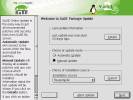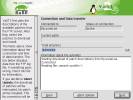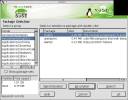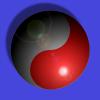Software :: Hardware :: Network/Basic
Network/Advanced :: Security and Users :: System :: Misc ::
Software
The YaST2 screenshot in the initial page of this report also shows the available Software setup options. These are Change source of installation, Online Update, System Update, Install/Remove software, and Patch CD Update.
The first, Change source of installation, is used to set the installation media for standard software packages. There are three options here: the default is CDROM. The other two are Nework and Hard disk. The latter is commonly used if you've got so much space that you've copied all your SuSE CDROMs to a local disk for ease of package grazing. The network option permits setting the server name and directory, both for complete network installation or for package updates (say on a laptop, while away from the CDROMs). Hmmmm. I can't make this work right - It keeps trying to mount a CD image. Ah. Even though SuSE's online documentation implies that it's for either FTP or NFS access, I snooped the network connection: It's only trying to NFS mount. I'm not going to go to that effort here, especially since I do have the CDROMs in hand.
 Now let's look at YOU: YaST2 Online Update. Unlike most other distributions, SuSE does apparently distribute patches to it's software when possible, rather than full replacement packages, either for upgrades or security updates. This makes for much more efficient bandwidth usage, both for standard dialup users, and especially for high per-minute rate dialup access, which is more prevalent in Europe, where SuSE is based.
Now let's look at YOU: YaST2 Online Update. Unlike most other distributions, SuSE does apparently distribute patches to it's software when possible, rather than full replacement packages, either for upgrades or security updates. This makes for much more efficient bandwidth usage, both for standard dialup users, and especially for high per-minute rate dialup access, which is more prevalent in Europe, where SuSE is based.
 After selecting a download source from the pull-down list, we continue with either an automatic or manual update process. In the latter, a list of applicable patches is downloaded, which can then be selected and applied, individually. or as a group. In automatic operation, usually all available patches are applied without user intervention. The exception I've found to this is when updates are present for YaST2. Then the auto process is interrupted, and we're prompted to rerun manually, installing just the YaST2 updates, then restart (the program) to get the rest. In my case, with a completely new set of KDE packages to retrieve, this could take a while for 150MB of data to download. I'll let it run. There, that's done. Works like a champ, I'm happy to report, with one eeensy, teensy, little exception: NEVER, EVER update running software... Say, like KDE. I ended up having to drop down to runlevel 3, and reinstall all the updates manually to get KDE working properly again. Whew, that was weird. Yes, there are still gotchas.
After selecting a download source from the pull-down list, we continue with either an automatic or manual update process. In the latter, a list of applicable patches is downloaded, which can then be selected and applied, individually. or as a group. In automatic operation, usually all available patches are applied without user intervention. The exception I've found to this is when updates are present for YaST2. Then the auto process is interrupted, and we're prompted to rerun manually, installing just the YaST2 updates, then restart (the program) to get the rest. In my case, with a completely new set of KDE packages to retrieve, this could take a while for 150MB of data to download. I'll let it run. There, that's done. Works like a champ, I'm happy to report, with one eeensy, teensy, little exception: NEVER, EVER update running software... Say, like KDE. I ended up having to drop down to runlevel 3, and reinstall all the updates manually to get KDE working properly again. Whew, that was weird. Yes, there are still gotchas.
The System Update option is used to upgrade the entire SuSE distribution. I'd maybe take this option to move the distribution from 7.3 to 7.4, when it comes out. This option starts by requiring that an installation source be selected and registered, so if a new source isn't first specified separately, System Update will run that process first, then backup the existing configurations, then update your system to the new version.
 Install/Remove Software is virtually identical to the process as documented in the installation review. Uninstalled software has no mark in the first column. Software already on the system is marked with an 'i' Packages can be selected (for installation), or deselected (for removal). Once all of the appropriate packages have been selected or deselected, click on OK to begin the rather drawn out installation process. Two drawbacks are immediately evident. First, the entire system configuration is rebuilt each time you run the installation process. Don't chose one package, install it, then do another. Decide (as best you can) what you want to add, and do it all at once. After the installation and configuration is complete, the dialog doesn't return - you are dropped back to the YaST2 Control Center level.
Install/Remove Software is virtually identical to the process as documented in the installation review. Uninstalled software has no mark in the first column. Software already on the system is marked with an 'i' Packages can be selected (for installation), or deselected (for removal). Once all of the appropriate packages have been selected or deselected, click on OK to begin the rather drawn out installation process. Two drawbacks are immediately evident. First, the entire system configuration is rebuilt each time you run the installation process. Don't chose one package, install it, then do another. Decide (as best you can) what you want to add, and do it all at once. After the installation and configuration is complete, the dialog doesn't return - you are dropped back to the YaST2 Control Center level.
How well does this package manager handle dependencies? Mmmm. How to test this? OK. When I select a package for installation that has dependencies, the other software is also automatically selected for installation, marked with an 'a'. Apparently, when one of several packages will satisfy a dependency, a selection sub-dialog is shown, to permit user choices. OTOH, when deselecting a package which other installed software depends upon, there's a dialog that warns of the dependent packages that are disabled by uninstallation of the deselected package. It's not quite like Debian's dpkg/apt system, where if you really want to remove a base package, all the dependent software is also removed - after all, it's pointless to retain bits that won't work, neh?
The Patch CD option is apparently useful for pulling down all the current patches for a version of SuSE Linux as a single disk image, which can then be used to update multiple systems. Using the search function on the SuSE website turns up nothing, however. Some extended spelunking through the SuSE site and FTP server also turns up nothing. This is a question for the SuSE support people if you run a number of SuSE systems - I can see it being faster, and handier than downloading the update patches individually for each machine.
Software :: Hardware :: Network/Basic
Network/Advanced :: Security and Users :: System :: Misc ::
All Content Copyright © 1999-2001 Brian P. Bilbrey.


 This, like all the other ODTL reports, is a purely personal and subjective report of my experiences with the software and/or hardware in question. If you try this at home, your results may match mine exactly. Alternatively, following these steps might make the neighbor boy start sleeping with sheep, cause your toaster oven to become Internet-connected, (then be hacked by some kid in Pasadena who lights your house on fire with it), and finally, may turn your low fat milk sour and chunky just as you raise the carton to your lips. YMMV, Caution Advised.
This, like all the other ODTL reports, is a purely personal and subjective report of my experiences with the software and/or hardware in question. If you try this at home, your results may match mine exactly. Alternatively, following these steps might make the neighbor boy start sleeping with sheep, cause your toaster oven to become Internet-connected, (then be hacked by some kid in Pasadena who lights your house on fire with it), and finally, may turn your low fat milk sour and chunky just as you raise the carton to your lips. YMMV, Caution Advised.

